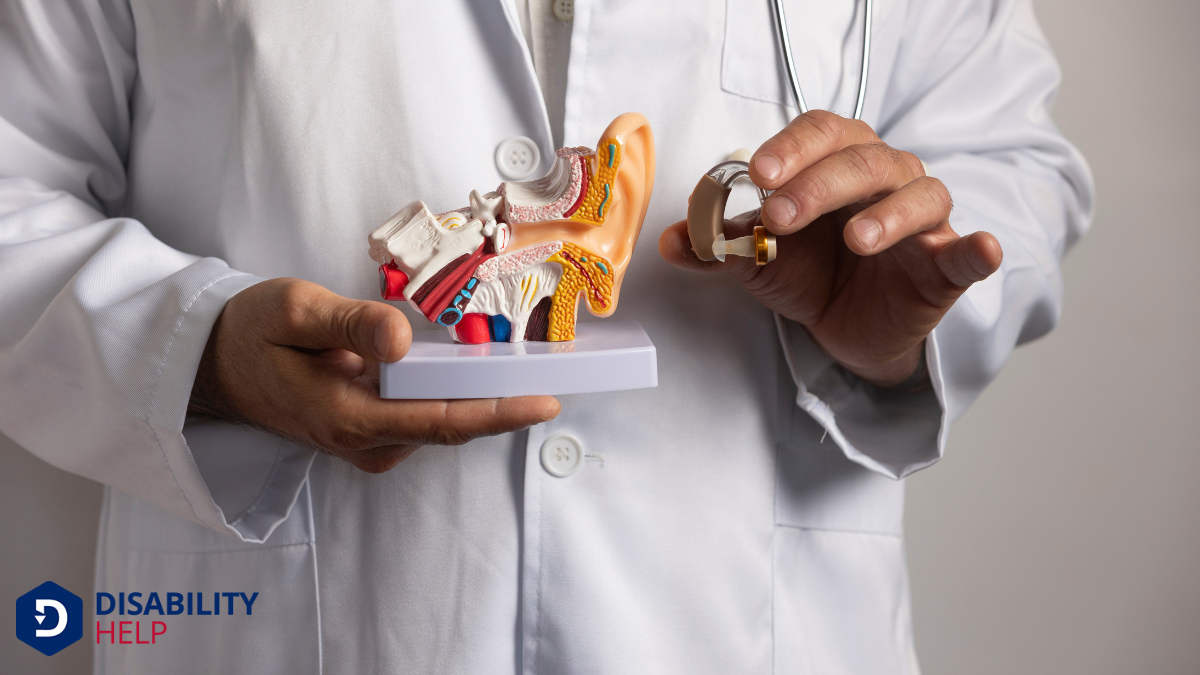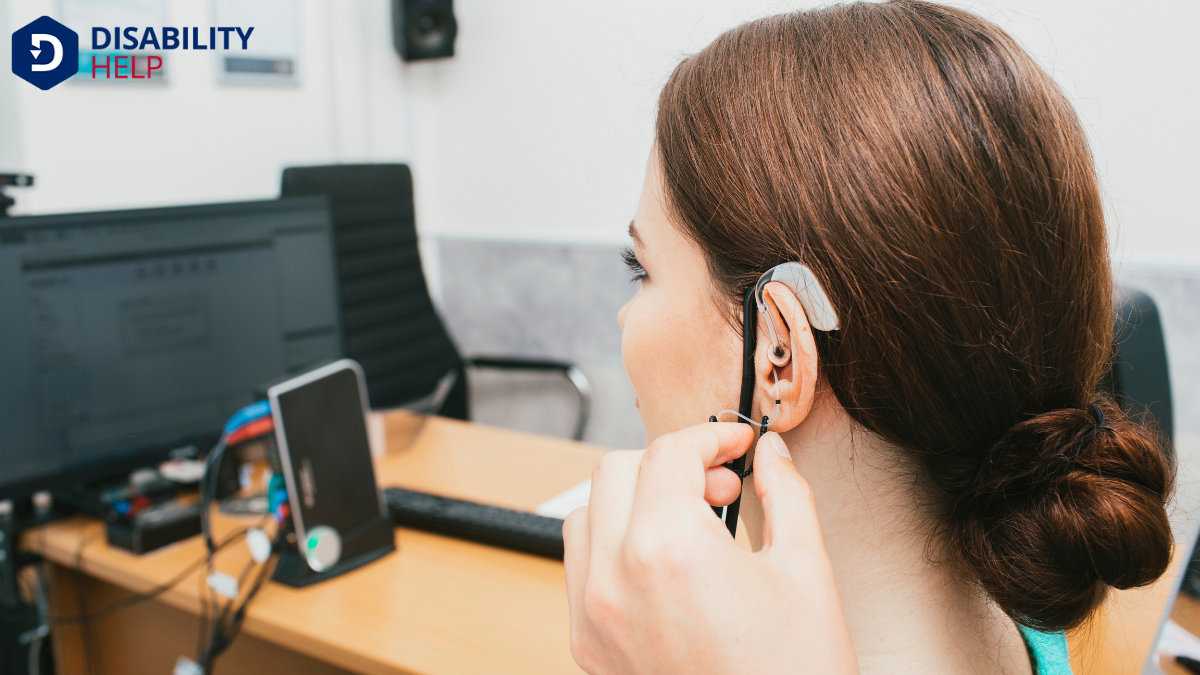Let's explore whether hearing aids truly fit the bill as assistive technology. It is understood they enhance communication for those with hearing impairments, but how do they compare to other devices in this category? With advancements like Bluetooth and AI, hearing aids have become more than just sound amplifiers. They empower users, fostering independence and inclusionThe practice of creating environments in which any individual or group can be and feel welcomed, res.... So, how exactly do these devices transform lives, and what does the future hold for their technology?
Key Takeaways
- Hearing aids are a form of assistive technology designed to enhance auditory capabilities for individuals with hearing impairments.
- They improve communication and independence, aligning with the primary goals of assistive technology.
- Modern hearing aids incorporate advanced features like AI and Bluetooth for personalized auditory experiences and connectivity.
- Assistive technology encompasses diverse tools, including hearing aids, addressing various disability needs such as mobility, communication, and cognition.
- Hearing aids help break communication barriers, fostering inclusion and engagement in social and environmental interactions.
Understanding Assistive Technology
Assistive technology encompasses a wide range of devices and tools designed to enhance the quality of life for individuals with disabilities. We often find these solutions in everyday items, like hearing aids, that many may not initially recognize as crucial.
By understanding assistive technology, we're better equipped to appreciate its impact on independence and communication. This technology spans various needs, from mobility aidsDevices designed to help individuals move around more easily, such as canes, walkers, or wheelchairs... to communication devices, all aiming to break barriers and foster inclusion.
It’s essential for us to grasp how these tools work so we can support their use and advocate for their development. Let’s focus on how these technologies empower individuals, enabling them to participate fully in society, and guarantee everyone has access to the tools they need to thrive.
The Evolution of Hearing Aids

Over the years, hearing aids have undergone significant transformations, evolving from bulky, rudimentary devices to sleek, sophisticated technology. Early models were cumbersome, often relying on basic amplification to enhance sound. They lacked precision and offered limited customization, which often resulted in unsatisfactory user experiences.
As our understanding of acoustics and digital technology advanced, hearing aids became more compact and effective. In the mid-20th century, transistor technology replaced vacuum tubes, making devices smaller and more reliable.
The digital revolution in the late 20th century marked a turning point, allowing for programmable settings and improved sound quality. Today, we stand at the forefront of innovation, with devices that effortlessly blend into our lives, offering us a seamless auditory experience.
As technology continues to advance, so too will hearing aids.
Key Features of Modern Hearing Aids
With the remarkable progress in hearing aid technology, we now enjoy devices packed with features that enhance our daily lives.
These modern marvels offer improved sound quality, allowing us to hear speech more clearly even in noisy environments. Many hearing aids automatically adjust settings based on our surroundings, making shifts seamless as we move from one place to another.
They're also designed to be discreet and comfortable, ensuring we can wear them all day without discomfort.
Additionally, advanced feedback cancellation reduces annoying whistling sounds, a common problem in older models. Rechargeable batteries eliminate the need for constant replacements, providing convenience and environmental benefits.
Directional microphones focus on the sounds we want to hear, while noise reduction features filter out unwanted background noise, enhancing our overall hearing experience.
The Role of Bluetooth and Smartphone Integration
Bluetooth technology has revolutionized how we interact with our hearing aids, offering seamless connectivity with smartphones and other devices. With this integration, we can easily control our hearing aid settings through an app, allowing for quick adjustments to suit different environments.
Imagine being at a noisy restaurant and adjusting the volume or switching to a program designed to filter background noise, all from our phones.
Moreover, Bluetooth lets us stream phone calls, music, and even GPS directions directly to our hearing aids. This direct streaming enhances sound quality and clarity, providing a more immersive and enjoyable listening experience.
Exploring AI Capabilities in Hearing Aids

Let's explore how AI is transforming hearing aids with features like AI-driven sound enhancement and advanced noise reduction algorithms.
These technologies work together to create personalized hearing profiles that adaptA grassroots disability rights organization in the U.S. that focuses on promoting community-based se... to our individual listening environments.
AI-Driven Sound Enhancement
Although traditional hearing aids have provided essential support for those with hearing impairments, AI-driven sound enhancement is revolutionizing how users experience sound. We’re now able to enjoy a more natural and personalized auditory experience.
AI technology in hearing aids adapts in real-time, recognizing and adjusting to different environments. This means we can focus on conversations with ease, even in complex settings.
Here’s how AI-driven sound enhancement transforms our listening experience:
- Dynamic sound processing: Automatically adjusts to changes in the environment.
- Personalized settings: Tailors the audio experience based on individual preferences.
- Real-time adaptation: Learns and evolves with our listening habits.
- Speech clarity: Enhances the speech, making conversations clearer.
- Environmental recognition: Differentiates between various soundscapes for peak hearing.
These advancements make hearing aids smarter and more efficient.
Noise Reduction Algorithms
When it comes to improving our auditory environment, noise reduction algorithms are a game changer in AI-driven hearing aids. These algorithms help us focus on the sounds we want to hear, like conversations, by identifying and reducing unwanted background noise.
They dynamically analyze sound waves and filter out ambient noise, making it easier for us to engage in social settings or busy environments.
Imagine trying to hear a friend speak at a bustling café; these algorithms work tirelessly to prioritize speech over clattering dishes and chatter.
By harnessing AI, hearing aids adapt in real-time to changing surroundings, offering us a clearer listening experience.
With such technology at our disposal, understanding speech amidst noise becomes much more manageable, enhancing our daily interactions.
Personalized Hearing Profiles
Many of us benefit from personalized hearing profiles, a remarkable advancement in AI-driven hearing aids.
These profiles allow our devices to tailor sound experiences specifically to our unique hearing needs. By leveraging AI, hearing aids learn and adapt to our environments and preferences, ensuring we're not missing out on life's important moments.
Let's explore how these profiles work:
- Custom Sound Settings: Align with our specific hearing lossPartial or total inability to hear sounds in one or both ears. frequency ranges.
- Adaptive Sound Environment: Automatically adjust to different soundscapes, like a quiet library or bustling restaurant.
- User Feedback Integration: Continuously improve by incorporating our feedback on sound quality.
- Real-Time Processing: Instantly adjust to changes in our surroundings for seamless hearing.
- Enhanced Speech Recognition: Focus on amplifying speech, making conversations clearer.
These features make hearing aids truly personalized.
The Impact of Hearing Aids on Daily Life
For those of us who rely on hearing aids, these devices can transform our daily lives in profound ways. They help us reconnect with the world by enhancing our ability to hear conversations, music, and environmental sounds.
Whether we're at a bustling cafe or a quiet park, hearing aids enable us to engage more fully with our surroundings. They reduce the strain of trying to understand speech, making social interactions more enjoyable and less exhausting.
At work, they improve our ability to communicate effectively, boosting our confidence and productivity. Hearing aids also play an essential role in maintaining personal relationships, allowing us to participate in family gatherings and social events without missing important moments.
With these devices, our world becomes more vibrant and connected.
User Empowerment Through Advanced Technology
When we explore how advanced technology in hearing aids empowers users, we're really talking about enhancing our daily life experiences.
With personalized sound adjustments, these devices adapt to our unique needs, allowing us to engage more fully with the world around us.
Let's consider how these innovations not only improve hearing but also boost our confidence and connection in everyday interactions.
Enhancing Daily Life Experiences
While technology continues to advance, hearing aids are becoming more than just tools for auditory enhancement; they're transforming into powerful devices that can greatly improve our daily lives.
We can now experience a richer, more connected existence thanks to their advanced features. Imagine how much more engaging our world becomes with these enhancements.
Here’s how hearing aids can enhance our daily life experiences:
- Seamless connectivity: Sync with smartphones and other devices for easy communication.
- Enhanced spatial awareness: Navigate environments with greater confidence.
- Noise reduction: Enjoy conversations without disruptive background noise.
- Activity tracking: Monitor physical activities, promoting healthier lifestyles.
- Language translation: Understand different languages in real-time.
These innovations empower us to connect, interact, and engage with our surroundings like never before.
Personalized Sound Adjustments
As hearing aids evolve, they offer personalized sound adjustments that empower us to tailor our auditory experiences precisely to our needs. We can now fine-tune settings with ease, allowing us to create an ideal listening environment.
Whether we’re in a bustling café or a quiet library, advanced technology guarantees we hear what’s important without unnecessary distractions.
These devices often come with smartphone apps, letting us adjust volumes or focus on specific sounds. This flexibility means we’re not just passive users but active participants in our hearing journey.
Comparing Hearing Aids to Other Assistive Devices

Though many types of assistive devices are available to enhance daily living, hearing aids stand out due to their specialized focus on auditory enhancement.
Unlike other devices, they directly address hearing loss, providing a unique solution for auditory challenges.
Let's explore how hearing aids compare to other assistive technologies:
- Mobility aids like wheelchairs offer physical support and independence.
- Visual aids such as screen readers help those with visual impairments.
- Cognitive aids include apps and planners that assist with memory and organization.
- Speech-generating devices give a voice to individuals with speech impairments.
- Environmental control systems allow users to operate home appliances with ease.
Each device serves a distinct purpose, but hearing aids specifically transform auditory experiences, seamlessly integrating into our daily lives.
The Importance of Customization and Personalization
Understanding the importance of customization and personalization in hearing aids is essential for maximizing their effectiveness. Each of us has unique hearing needs, and our environments vary widely. By customizing hearing aids, we guarantee they cater specifically to our individual hearing loss patterns.
Personalization allows us to adjust settings depending on the situation, whether we’re in a quiet room or a crowded space. These tailored adjustments enhance sound clarity and improve our overall listening experience.
When we work closely with audiologists to fine-tune these devices, we empower ourselves to engage more fully in conversations and activities. This level of customization doesn’t just improve hearing; it greatly enhances our quality of life by addressing our specific needs, making hearing aids truly effective assistive tools.
Future Trends in Hearing Aid Technology
While we’ve seen remarkable advancements in hearing aid technology over the years, future trends promise even greater innovations to enhance our auditory experiences.
Imagine hearing aids that adapt seamlessly to our surroundings, offering improved clarity and comfort. Here are some exciting developments we can expect:
- Artificial Intelligence: AI-driven features will personalize sound settings automatically, adapting to our environment.
- Connectivity: Enhanced integration with smart devices will make streaming audio more seamless than ever.
- Rechargeability: Batteries will become more efficient, lengthening usage time between charges.
- Health Monitoring: Built-in sensors could track our health metrics, providing valuable data to improve our well-being.
- Miniaturization: Smaller, discreet designs will deliver powerful performance without drawing attention.
Let’s embrace these advancements set to transform our interaction with sound.
Conclusion
In our exploration of hearing aids as assistive technology, we've seen how these devices have evolved to include cutting-edge features like Bluetooth and AI. They're not just amplifiers; they're gateways to a more connected and inclusive life. By comparing them to other assistive devices, it's clear they stand out in personalization and empowermentThe process of gaining control, authority, and power over one’s life, often used in the context of.... As technology advances, we can't wait to see how future innovations will continue to enhance the lives of those with hearing impairments.






